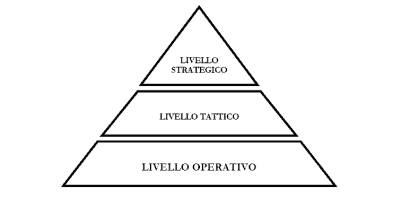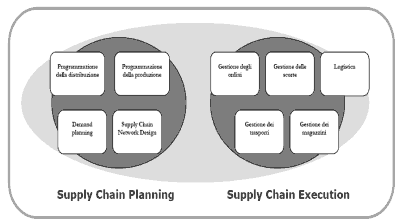4.3 Functionalities and benefits
With Supply Chain Management one agrees the management of planning processes, implementation and control of all
the flow of activity and communication between various subjects (companies, suppliers, partner, customers), finalizes to you to supply
to the customer/consumer the assets demands to the asked conditions, elements which the customer attributes value.
The Supply Chain Management can have also others objects to you: reduction of the price of the products, Time-to-market, differentiation,
consolidation in niche markets.
The role of the ICT (Information and Comunication Technology) in the Supply Chain Management is that one to support an informative
base for the various been involved subjects, to allow the optimization of the service to the customer, to increase the communication
speed, to reduce the process costs, to trace the information, to concur fast reactions to unexpected events
that are taken place along the virtual chain.
The methods informed to us usable in order to avoid efficiency decrease and to maintain to fluid the informative flow along the logistic
chain are substantially of three types: some great companies impose an informative system common to their suppliers
and subfornitori in order to slim and to simplify the process; others use technologies IP (Internet, Intranet, Extranet, email)
that they allow to communicate in effective and direct way with suppliers and customers, independently from the systems
legacy in use; other anchor uses ERP (Enterprise Resource Planning) that they comprise the necessary modules to the management
of the entire chain of the value (between which SCM).
This last solution adapted particularly to those companies that they possess productive warehouses and systems
is dislocated to you in distant localities between they and from the business center; accessibility via Internet, Intranet, EDI makes yes that
the information are available, in real time, where necessary. Through this solution the obtainable benefits are:
- transparency and visibility on entire supply chain of regarding data ties, saturation of resources and I use of materials;
- greater speed in taking decisions in order to answer adequately to all the variations, is inner that external, than impattano on the normal flow of supplying production delivery;
- better I use of the resources and reduction of the warehouse lyings;
- better service and better information to the customer.
The optimization of the procedures of management, supplying and delivery needs fundamentalally of instruments
effective and innovated to you in a position to eliminating the problematic ones tied to the communication and the sharing of the information,
to the aim to reduce in sensitive way the relative costs you (telephone, fax, hours job), the times of supplying and follow up.
Instruments SCM answer mainly to this object to you, that is to the attainment of the maximum efficiency in the processes
of communication and the flows informed you along the logistic chain extended (from the sub-supplier the final customer).
The optimization of the Supply Chain management is developed on three levels:
- on the plan strategic draft to define the structure and I use it of network the physicist in order to catch up objects it you of business to minor the cost;
- on the tactical plan the SCM regards the activities of forecast of the question, production, of the distribution and the transport and the relati to you methods of management;
- on the operations plan, it regards the programming of the operations and the transmission in real time of the information that concur of having the acquaintance of the state of the single plant.

Figure 4.2- Levels of optimization of the Supply Chain Management
Always with reference to the functionalities, the SCM applications can be subdivided in two segments: Supply Chain Planning
and Supply Chain Execution.
The first segment groups and analyzes the contained information in the database business in order to preview the question and consequently
to program the production; it can be applied for operating decisions and strategies of along term.
According to segment it uses the information generated from the first one in order to guide the production, the logistics and the movements of
raw materials, members and finished products, it can be used in order to determine the productive ability and to create a production plan
that satisfies the question requirements and is adaptable to the changes.
We bring back under, in figure 5, the functionalities of the SCM divided for segments:
In synthesis, the three main ones object you of a system SCM are:
- lessening of the warehouse costs tying the production to the question: the applications use complexes planning algorithms in order to preview the question on the base of the information contained in the database;

Figure 4.3- Functionality of the Supply Chain Management
- cost reduction totals of production velocizzando the flow of goodses inside of the production process and improving the informative flow between the company, the suppliers, the distributors. Assuring the connettivitą between the several parts of the Supply Chain, these applications allow the companies to diminish the died times, the supplyes and to prevent the necks of bottle in the production process;
- improvement of the satisfaction of the customer offering speed of delivery and personalizzazioni of product.
The main benefits legacies to the adoption of solutions SCM are clearly identify to you from the three “C”:
- cooperation: through the relative communication and exchange of information to level of the supplyes, previsional data, trend of sale, trend of the question, the level of cooperation between the subject presents long the Supply Chain increases in meaningful way;
- coordination: the coordination of the operations allows to reduce the times between the order and the delivery, being adopted an approach just in Time;
- communication: the communication through protocol IP and the transfer of documents through EDI concur of monitorare in effective way the various ones are made of management of the order.
Adopting a solution SCM, the companies they can gain ulterior advantages in more aspects of their activity:
- reduction of the circulating understood one them, that it can be obtained through smaller supplyes and a faster cycle cash to cash;
- efficiency of the investments, obtainable carrying out a reorganization of the warehouses and having one greater availability of information to support of the decisional process in area production (es. chosen make or buy of some members of the end product);
- improvement of the service to the final customer;
- cost reduction, obtainable automating the daily repetitive operations, comparto packaging and shipments;
- increment of the revenues, caught up thanks to the possibility of personalizzazione of the product.
Currently systems SCM are not much diffuse, although strong increase of the installations in the next years is previewed
one: such evolution will be supported also from the fast spread of Internet and the e-commerce, activity that door with
himself a ripensamento of the logistic chain.
That that, until today, has hindered one more wide adoption than solutions SCM, or that however it has refrained the decision
to implement them, has been mainly the resistance to the organizational change, followed from the costs of implementation
and long times for integration.

